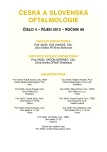Ocular Trauma in Childhood at the University Hospital Ostrava in the Years 2007–2011
Authors:
J. Timkovič; P. Šmehlík; D. Cholevík; J. Němčanský; R. Kiszová; P. Mašek
Authors‘ workplace:
Oční klinika Fakultní nemocnice, Ostrava, přednosta MUDr. Petr Mašek, CSc.
Published in:
Čes. a slov. Oftal., 69, 2013, No. 4, p. 149-154
Category:
Original Article
Práce byla ve zkrácené podobě přednesena ve formě elektronického posteru na Světovém kongresu dětské oftalmologie a strabismu konající se v době od 7. do 9. září 2012 v Miláně v Itálii. Ve zkrácené podobě byla práce přednesena na akci – III. trendy v dětské oftalmologii a strabologii konající se 1.–2. června 2012 v Lázních Bělohrad. V článku byl použit text z původní atestační práce MUDr. Juraje Timkoviče po jednomyslném odsouhlasení atestační komise.
Overview
Objective:
to investigate and analyze the group of child patients with ocular trauma in the Ostrava region in the Czech Republic.
Methods:
A retrospective observational case series. We reviewed and analyzed clinical records of all the paediatric patients with ocular trauma treated at the University Hospital Ostrava in the years 2007 – 2011. Age, sex, mechanism of injury, type of ocular trauma, the consequences of injury and period of the year when the accident occurred were evaluated. BETT classification used in this study was modified and extended by chemical and thermal injuries and orbital trauma. Ocular burns, including thermal and chemical burns, were graded using the classification for ocular surface burns by Dua.
Results:
448 children (309 boys, 139 girls), aged from 3 months to 17 years (median 10 years) were included in this study. The most common ocular injury was closed globe injury (253 patients, 56,5 %), the next common were orbital injuries (149 patients, 33,3 %), burns injuries (39 patients, 8,7 %), the least frequent were open globe injuries (7 patients, 1,6 %). The most common mechanism of ocular trauma was hit by object (34,6 %), followed by trauma caused by blows and falls (15,2 %) and hit by another person (10,3 %). The 50,9 % of injuries occurred in days of school attendance. 10,3 % of injuries occured directly at the school or preschool facilities. 6,5 % of the injuries were polytraumas, which required interdisciplinary cooperation.
Conclusion:
This study demonstrated that the incidence of eye injuries is greater in boys, mainly adolescents. Closed globe injuries are the predominant type of ocular trauma in childhood. The mechanism of ocular trauma is variable. Nonetheless there is a relation between the mechanism and the age of the child. Further research in terms of how the preventive measures would affect the incidence and severity of ocular trauma in children would be beneficial. The modified BETT classification of ocular trauma, including chemical and thermal injuries and orbital trauma may better adress current requirements.
Key words:
ocular trauma, childhood, mechanism of ocular trauma
Sources
1. Dua, H. S, King, A. J., Joseph, A.: A new classification of ocular surface burns. British J Ophthalm. 2001; 85, 11: 1379–1383. ISSN 00071161.
2. Gajová, H., Řehůřek, J.: Poranění oka kuličkovou pistolí u dětí. Čs Pediat. 2000; 55, 5: 309–312. ISSN 0069-2328.
3. Gerinec, A.: Detská oftalmológia. Martin (Slovenská republika): Vydavateľstvo Osveta, 01/2005, s. 543–560. ISBN 80-8063-181-6.
4. Karaman, K., Znaor, L., Lakos, V., et al.: Epidemiology of Pediatric Eye Injury in Split-Dalmatia Country. Ophthalmic Research. 2009; 42, 4: 199–204. ISSN 1423-0259.
5. Kuhn, F., Morris, R., Witherspoon, C. D., et al.: A standardized classification of ocular trauma. Graefe’s archive for clinical and experimental ophthalmology = Albrecht von Graefes Archiv für klinische und experimentelle Opthalmologie. 1996; 234, 6: 399–403. ISSN 0721-832x.
6. Kuhn, F., Morris, R., Witherspoon, C.D.: Birmingham Eye Trauma Terminology (BETT): terminology and classification of mechanical eye injuries. Ophthalmology Clinics of North America. 2002; 15, 2: 139–143. ISSN 08961549.
7. Kuhn, F., Morris, R., Witherspoon, C. D., et al.: The Birmingham Eye Trauma Terminology system (BETT). J Franćais d’Ophtalmol. 2004; 27, 2: 206–210. ISSN 01815512.
8. Macewen, C. J, Baines, P. S., Desai, P.: Eye injuries in children: the current picture. British Journal of Ophthalmology. 1999; 3, 8: 933–936. ISSN 0007-1161.
9. Moreira, C. A., Debert-Ribeiro, M., Belfort, R., Jr.: Epidemiological Study of Eye Injuries in Brazilian Children. Archives of Ophthalmol. 2003; 06: 81–84. ISSN 0003-9950.
10. Pieramici, D. J., Sternberg, P., Jr, Aaberg, T. M., Sr, et al.: A system for classifying mechanical injuries of the eye (globe). Am J. Ophthalmol. 1997; 123:820-831. ISSN 0002-9394.
11. Rapoport, I., Romem, M., Kinek, M., et al.: Eye injuries in children in Israel. A nationwide collaborative study. Arch Ophthalmol. 1990; 08(3):376-379.
12. Serrano, J. C., Chalela, P., Arias, J. D.: Epidemiology of Childhood Ocular Trauma in a Northeastern Colombian Region. Archives of Ophthalmology. 2003; 106, 6: 1439–1445. ISSN 0003-9950.
13. Strahlman, E., Elman, M., Daub, E., Baker, S.: Causes of pediatric eye injuries. A population-based study. Arch Ophthalmol. 1990; 180(4): 603–606.
Labels
OphthalmologyArticle was published in
Czech and Slovak Ophthalmology

2013 Issue 4
Most read in this issue
- Contemporary Possibilities of Intraocular Pressure Measurement
- Analysis of Reasons of Intraocular Lenses Explantation
- Ocular Trauma in Childhood at the University Hospital Ostrava in the Years 2007–2011
- Anterior Uveitis Caused by Electrical Discharge in Whole Body Injuries (Fifteen Years Study)
